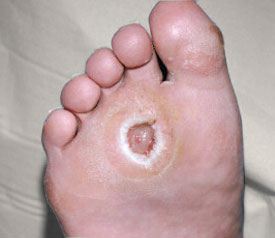
Patients with diabetic ulcers and sores know the importance of taking good care of their wounds. Poor wound care can cause slow healing or major issues down the road. Using proper wound dressings and practicing good would care are vital to the healing process.
While there are a variety of wound dressings for diabetic ulcers and sores, proper adhesion of the dressing is vital. Hy-Tape is a waterproof adhesive tape that holds tight without irritating the skin. It can easily be replaced when needed and prevents moisture from affecting the damaged skin.
Diabetic sores and ulcers can be a major nuisance, but proper care and treatment can make them more manageable. Here are some tips and tricks for caring for diabetic sores and ulcers as a patient or caregiver.
How to avoid diabetic sores and ulcers
If at all possible, it’s best for diabetic patients to avoid developing sores or ulcers. There are a few steps that could help:
- Monitor glucose levels – It’s vital that all diabetic patients monitor their glucose levels. Checking levels multiple times throughout the day can help in avoiding diabetic ulcers, sores, and other health issues. Knowing when you need insulin can help you avoid major health problems.
- Avoid unnecessary strain – A common issue for diabetics is pain in the feet and hands. Avoiding overexertion and pressure on the hands and feet can help you avoid developing sores or ulcers. Diabetes can weaken the nerves, especially in the feet. With proper care, you can avoid developing skin sores.
- Take care of other health issues – There are many other health problems that can add additional stress to the body, leading to diabetic sores and ulcers. Heart disease, kidney disease, and obesity can all make a diabetic more susceptible to sores and ulcers. Working with a doctor to treat these issues can help you stay healthier overall.
Unfortunately, most diabetics will develop sores or ulcers at some point. Luckily, treatment and care for the sores can be fairly easy.
Why do diabetic sores occur?
There are many different causes of diabetic sores and ulcers. Patients with diabetes should be on the lookout for these situations in their life before a sore or ulcer appears:
- Hyperglycemia – This is a condition that occurs when blood sugar is too high for too long of a period of time. A common issue for diabetics, hyperglycemia can cause many different health issues, including the outbreak of a sore or wound.
- Bad blood circulation – When the blood doesn’t flow well through a part of the body, an ulcer or sore can appear. Proper blood flow is essential to every area of a person’s body, and low blood flow can sometimes be noticed by coldness or numbness.
- Nerve damage – Diabetes can cause damage to the nerves throughout the body, especially in the extremities. When someone with diabetes has constant numbness of the skin, they could have permanent nerve damage. These areas are especially susceptible to diabetic ulcers and sores.
No matter the reason for a diabetic sore or ulcer, it’s important to take care of the skin to heal the area as well as possible.
Learn more about caring for a diabetic wound.
Best wound dressings for diabetic sores
Using the right wound dressing is essential for the proper healing of a diabetic ulcer or sore. There are many different wound dressings on the market. Here are a few types of wound dressings that have been proven effective:
- Dressings made of healthy skin – Many wound dressings made today feature living human skin cells. These dressings can help the body repair much faster than synthetic dressings.
- Dressings that are multi-layered – Wound dressings can come in multi-layered forms. These dressings provide the body with the cells they need to repair layer-by-layer, ensuring a thorough repair.
- Dressings that are cryopreserved dermal substitutes – Some dressings are made of neonatal cells and fashioned in a lab. These dressings help the skin repair quickly.
No matter the type of wound dressing being used, proper adhesion is vital. Hy-Tape provides a strong hold while being sensitive to the skin. Hy-Tape adhesives ensure that the wound dressing will stay in place, stay comfortable, and stay safe.
Learn more about managing diabetic ulcers.
A few tips for proper ulcer and sore healing
Diabetic ulcers and sores can be a major nuisance, so taking proper actions when healing is important. Here are a few things a patient can do to help ensure consistent care and healing:
- Be mindful of infection – If the area around the skin seems to be infected, taking care of the infection quickly is vital. The sooner the infection is removed, the sooner the skin can heal properly.
- Perform wound healing stimulation when necessary – Sometimes, the skin will not be able to heal and needs to be removed. Getting rid of dead skin will help the overall healing process move quicker.
- Practice proper nutrition – Keeping glucose levels in check will help diabetic wounds heal faster and more fully. With proper nutrition, a sore or ulcer can heal more fully and quickly.
- Ensure proper wound dressing adhesion – Keeping a wound dressing in place is important to the healing process. Hy-Tape is made for holding wound dressings in place, keeping moisture out, and protecting the skin around the affected area.
Hy-Tape makes the process of wound care much easier and cost-effective. The adhesive in Hy-Tape ensures a strong hold without the risk of further skin damage. It’s also waterproof, helping to keep the wound safe from unnecessary moisture. Whether a patient with diabetic wounds or a caregiver, consider Hy-Tape as your adhesive material of choice.

